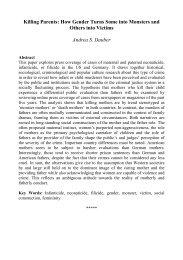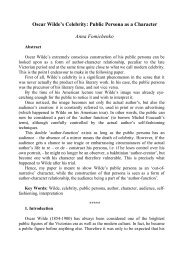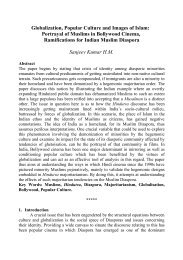“These three avant-garde designers have become an international ...
“These three avant-garde designers have become an international ...
“These three avant-garde designers have become an international ...
Create successful ePaper yourself
Turn your PDF publications into a flip-book with our unique Google optimized e-Paper software.
different institutions, both treated Yamamoto as working in a non-fashion design mode. 9<br />
Fr<strong>an</strong>çois Baudot likens Yamamoto’s work to the 1960s conceptual art movement,<br />
whose practitioners, he argues, “sought to replace the work of art itself with the idea of<br />
underlying it, the project of its gestation, the <strong>an</strong>alysis of its concept <strong>an</strong>d its effects.” 10<br />
Curators <strong>have</strong> emphasized the conceptual, as opposed to the formal, qualities of his work.<br />
In 2006, Yamamoto’s work was again placed on a parallel with architecture at the<br />
Museum of Contemporary Art in Los Angeles in Skin + Bones: Parallel Practices in<br />
Fashion <strong>an</strong>d Architecture, which explored the work of both architects, such as Zaha<br />
Hadid <strong>an</strong>d Fr<strong>an</strong>k Gehry, <strong>an</strong>d fashion <strong>designers</strong>. In this case, however, curator Brooke<br />
Hodge explored “the common visual <strong>an</strong>d intellectual principles [of the two disciplines],”<br />
from their direct relationship with space <strong>an</strong>d the hum<strong>an</strong> body to ideas of shelter, identity,<br />
creative process <strong>an</strong>d stylistic tendencies such as Yamamoto’s interest in the<br />
deconstruction of form to rethink traditional tailored garments.<br />
Designers in 1980s fashion, like their conceptualist counterparts, sought engagement<br />
with everyday life, <strong>an</strong>d found their inspiration in the real world <strong>an</strong>d its inhabit<strong>an</strong>ts.<br />
Likewise, Yohji Yamamoto sought a distinct <strong>an</strong>d intimate relationship with his wearer.<br />
He attempts to create clothing that corresponds exactly to the individual <strong>an</strong>d at the same<br />
time conforms to a system of typologies that look to the past, at odds with fashion’s<br />
fleeting game <strong>an</strong>d obsession with newness. According to one wearer, “I had always<br />
w<strong>an</strong>ted to underst<strong>an</strong>d how the Jap<strong>an</strong>ese fashion designer Yohji Yamamoto, a m<strong>an</strong> of a<br />
different generation <strong>an</strong>d a very different culture from my own, could know so exactly<br />
what I w<strong>an</strong>ted to wear <strong>an</strong>d how to express my identity through a piece of clothing.” 11 In<br />
looking to the pre-modern consumer culture past he envisions a time when people<br />
4

















